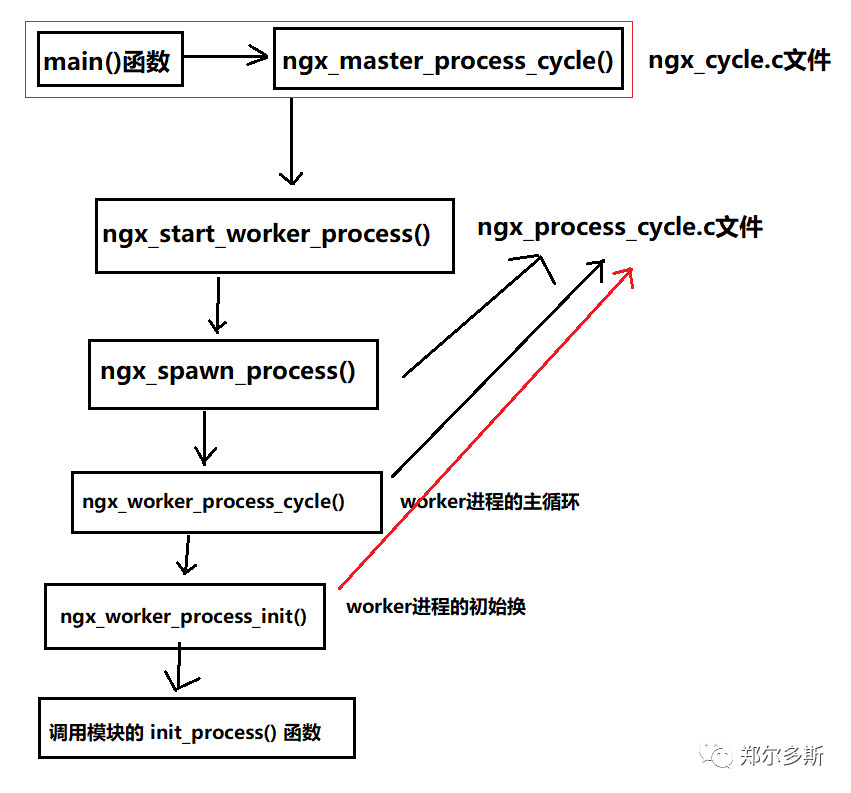微信公众号:郑尔多斯
关注可了解更多的Nginx知识。任何问题或建议,请公众号留言;
关注公众号,有趣有内涵的文章第一时间送达!
内容回顾
前面的几篇文章中,我们介绍了nginx的事件模块的基础知识。我们知道nginx中包含了三个与事件相关的module,分别为ngx_event_module,ngx_event_core_module,ngx_epoll_module。我们也分别分析了这三个模块的配置文件的解析过程,从本篇文章开始,将详细分析nginx的事件处理过程,比如如何添加事件,删除事件,处理事件等。
事件处理的概述
事件处理模块的主要解决的问题是如何收集,分发以及管理事件。在nginx中,事件主要包含网络事件和定时器事件。当然还有其他事件,比如master进程和worker进程通信也是使用事件机制来完成的,但是我们的关注点主要在前两种事件,第三种事件以后会分析。前面我们分析了nginx是如何解析配置文件中与事件有关的配置项的,我们知道,当遇到events{}的时候,表示开始处理事件配置项了。
事件和连接
作为web服务器,每一个用户请求至少对应一个TCP连接,每个连接都包含一个毒事件和一个写事件。这样epoll就可以根据触发的事件类型来调度相应的模块进行处理。Nginx连接分为主动连接和被动连接。分别用ngx_connection_t和ngx_peer_connection_t结构体来表示。
主动连接: 客户端发起,服务器被动接受的连接
被动连接:Nginx作为客户端,向上游服务器发起的连接
本系列文章所介绍的连接都是被动连接,即Nginx作为服务器被动的接受客户端发起的连接。
Nginx连接池
为了提高效率,Nginx在启动的时候,会创建好连接池和对应的读写事件,并且将每个连接都和对应的读写事件对应起来。这样的话,在后面使用到连接的时候,只需要从连接池中获取一个空闲的连接就行了。那么Nginx是在什么时候创建了连接池和读写事件呢?
前面两篇文章我们介绍了ngx_events_module, ngx_event_core_module, ngx_epoll_module的配置项解析过程,以及create_conf(), init_conf()方法。我们知道ngx_module_t结构体有中有许多钩子函数,其中有一个钩子函数为init_process(),这个方法会在Nginx启动过程中调用。在master/worker模式下,当创建了worker进程之后,会在worker进程的初始化过程中调用init_process()。
通过源码可以发现,与事件机制相关的三个模块中,只有ngx_event_core_module有一个init_process()钩子函数,为ngx_event_process_init()。其他两个模块都没有对应的钩子函数。
具体的调用过程如下:

ngx_event_process_init
下面我们就分析一下这个ngx_event_process_init()这个方法。
static ngx_int_t
ngx_event_process_init(ngx_cycle_t *cycle)
{
ngx_uint_t m, i;
ngx_event_t *rev, *wev;
ngx_listening_t *ls;
ngx_connection_t *c, *next, *old;
ngx_core_conf_t *ccf;
ngx_event_conf_t *ecf;
ngx_event_module_t *module;
ccf = (ngx_core_conf_t *) ngx_get_conf(cycle->conf_ctx, ngx_core_module);
ecf = ngx_event_get_conf(cycle->conf_ctx, ngx_event_core_module);
if (ccf->master && ccf->worker_processes > 1 && ecf->accept_mutex) {
ngx_use_accept_mutex = 1;
ngx_accept_mutex_held = 0;
ngx_accept_mutex_delay = ecf->accept_mutex_delay;
} else {
ngx_use_accept_mutex = 0;
}
ngx_queue_init(&ngx_posted_accept_events);
ngx_queue_init(&ngx_posted_events);
if (ngx_event_timer_init(cycle->log) == NGX_ERROR) {
return NGX_ERROR;
}
for (m = 0; cycle->modules[m]; m++) {
if (cycle->modules[m]->type != NGX_EVENT_MODULE) {
continue;
}
if (cycle->modules[m]->ctx_index != ecf->use) {
continue;
}
module = cycle->modules[m]->ctx;
if (module->actions.init(cycle, ngx_timer_resolution) != NGX_OK) {
/* fatal */
exit(2);
}
break;
}
#if !(NGX_WIN32)
if (ngx_timer_resolution && !(ngx_event_flags & NGX_USE_TIMER_EVENT)) {
struct sigaction sa;
struct itimerval itv;
ngx_memzero(&sa, sizeof(struct sigaction));
sa.sa_handler = ngx_timer_signal_handler;
sigemptyset(&sa.sa_mask);
if (sigaction(SIGALRM, &sa, NULL) == -1) {
ngx_log_error(NGX_LOG_ALERT, cycle->log, ngx_errno,
"sigaction(SIGALRM) failed");
return NGX_ERROR;
}
itv.it_interval.tv_sec = ngx_timer_resolution / 1000;
itv.it_interval.tv_usec = (ngx_timer_resolution % 1000) * 1000;
itv.it_value.tv_sec = ngx_timer_resolution / 1000;
itv.it_value.tv_usec = (ngx_timer_resolution % 1000 ) * 1000;
if (setitimer(ITIMER_REAL, &itv, NULL) == -1) {
ngx_log_error(NGX_LOG_ALERT, cycle->log, ngx_errno,
"setitimer() failed");
}
}
if (ngx_event_flags & NGX_USE_FD_EVENT) {
struct rlimit rlmt;
if (getrlimit(RLIMIT_NOFILE, &rlmt) == -1) {
ngx_log_error(NGX_LOG_ALERT, cycle->log, ngx_errno,
"getrlimit(RLIMIT_NOFILE) failed");
return NGX_ERROR;
}
cycle->files_n = (ngx_uint_t) rlmt.rlim_cur;
cycle->files = ngx_calloc(sizeof(ngx_connection_t *) * cycle->files_n,
cycle->log);
if (cycle->files == NULL) {
return NGX_ERROR;
}
}
#else
if (ngx_timer_resolution && !(ngx_event_flags & NGX_USE_TIMER_EVENT)) {
ngx_log_error(NGX_LOG_WARN, cycle->log, 0,
"the \"timer_resolution\" directive is not supported "
"with the configured event method, ignored");
ngx_timer_resolution = 0;
}
#endif
cycle->connections =
ngx_alloc(sizeof(ngx_connection_t) * cycle->connection_n, cycle->log);
if (cycle->connections == NULL) {
return NGX_ERROR;
}
c = cycle->connections;
cycle->read_events = ngx_alloc(sizeof(ngx_event_t) * cycle->connection_n,
cycle->log);
if (cycle->read_events == NULL) {
return NGX_ERROR;
}
rev = cycle->read_events;
for (i = 0; i < cycle->connection_n; i++) {
rev[i].closed = 1;
rev[i].instance = 1;
}
cycle->write_events = ngx_alloc(sizeof(ngx_event_t) * cycle->connection_n,
cycle->log);
if (cycle->write_events == NULL) {
return NGX_ERROR;
}
wev = cycle->write_events;
for (i = 0; i < cycle->connection_n; i++) {
wev[i].closed = 1;
}
i = cycle->connection_n;
next = NULL;
do {
i--;
c[i].data = next;
c[i].read = &cycle->read_events[i];
c[i].write = &cycle->write_events[i];
c[i].fd = (ngx_socket_t) -1;
next = &c[i];
} while (i);
cycle->free_connections = next;
cycle->free_connection_n = cycle->connection_n;
/* for each listening socket */
ls = cycle->listening.elts;
for (i = 0; i < cycle->listening.nelts; i++) {
#if (NGX_HAVE_REUSEPORT)
if (ls[i].reuseport && ls[i].worker != ngx_worker) {
continue;
}
#endif
c = ngx_get_connection(ls[i].fd, cycle->log);
if (c == NULL) {
return NGX_ERROR;
}
c->type = ls[i].type;
c->log = &ls[i].log;
c->listening = &ls[i];
ls[i].connection = c;
rev = c->read;
rev->log = c->log;
rev->accept = 1;
#if (NGX_HAVE_DEFERRED_ACCEPT)
rev->deferred_accept = ls[i].deferred_accept;
#endif
if (!(ngx_event_flags & NGX_USE_IOCP_EVENT)) {
if (ls[i].previous) {
/*
* delete the old accept events that were bound to
* the old cycle read events array
*/
old = ls[i].previous->connection;
if (ngx_del_event(old->read, NGX_READ_EVENT, NGX_CLOSE_EVENT)
== NGX_ERROR)
{
return NGX_ERROR;
}
old->fd = (ngx_socket_t) -1;
}
}
#if (NGX_WIN32)
#else
rev->handler = (c->type == SOCK_STREAM) ? ngx_event_accept
: ngx_event_recvmsg;
#if (NGX_HAVE_REUSEPORT)
if (ls[i].reuseport) {
if (ngx_add_event(rev, NGX_READ_EVENT, 0) == NGX_ERROR) {
return NGX_ERROR;
}
continue;
}
#endif
if (ngx_use_accept_mutex) {
continue;
}
#if (NGX_HAVE_EPOLLEXCLUSIVE)
if ((ngx_event_flags & NGX_USE_EPOLL_EVENT)
&& ccf->worker_processes > 1)
{
if (ngx_add_event(rev, NGX_READ_EVENT, NGX_EXCLUSIVE_EVENT)
== NGX_ERROR)
{
return NGX_ERROR;
}
continue;
}
#endif
if (ngx_add_event(rev, NGX_READ_EVENT, 0) == NGX_ERROR) {
return NGX_ERROR;
}
#endif
}
return NGX_OK;
}
这个函数的主要逻辑如下;
- 获取我们的全局
ngx_core_conf_t配置结构体和事件模块的配置结构体ngx_event_conf_t
- 初始化
ngx_posted_accept_events和ngx_posted_events,这两个都是队列,用来保存需要滞后处理的连接和事件。 - 初始化时间红黑树
- 遍历所有的
Nginx模块,找到我们选择的事件模块,比如ngx_epoll模块,然后调用该事件模块的init()方法(该方法下一篇文件进行分析) - 对时间参数进行处理(之后分析这部分)
connection,read event,write event进行处理- 对
cycle-\>listening中的监听端口分配connection
下面我们看一下connection`, `read event`, `write event`的生成逻辑,如下:
cycle->connections =
ngx_alloc(sizeof(ngx_connection_t) * cycle->connection_n, cycle->log);
if (cycle->connections == NULL) {
return NGX_ERROR;
}
c = cycle->connections;
cycle->read_events = ngx_alloc(sizeof(ngx_event_t) * cycle->connection_n,
cycle->log);
if (cycle->read_events == NULL) {
return NGX_ERROR;
}
rev = cycle->read_events;
for (i = 0; i < cycle->connection_n; i++) {
rev[i].closed = 1;
rev[i].instance = 1;
}
cycle->write_events = ngx_alloc(sizeof(ngx_event_t) * cycle->connection_n,
cycle->log);
if (cycle->write_events == NULL) {
return NGX_ERROR;
}
wev = cycle->write_events;
for (i = 0; i < cycle->connection_n; i++) {
wev[i].closed = 1;
}
i = cycle->connection_n;
next = NULL;
do {
i--;
c[i].data = next;
c[i].read = &cycle->read_events[i];
c[i].write = &cycle->write_events[i];
c[i].fd = (ngx_socket_t) -1;
next = &c[i];
} while (i);
cycle->free_connections = next;
cycle->free_connection_n = cycle->connection_n;
上面的代码很简单,就是根据配置文件中的参数,生成对应数量的连接数,并根据下标将连接和读写事件相关联。并把空闲连接的放置在free_connection链表中
喜欢本文的朋友们,欢迎长按下图关注订阅号郑尔多斯,更多精彩内容第一时间送达
























 703
703

 被折叠的 条评论
为什么被折叠?
被折叠的 条评论
为什么被折叠?








